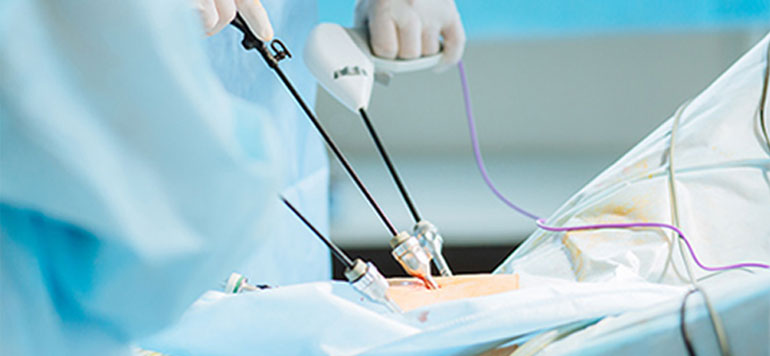Laparoscopy is an operation performed in the abdomen or pelvis using small incisions (usually 0.5–1.5 cm) with the aid of a camera. The laparoscope aids diagnosis or therapeutic interventions with a few small cuts in the abdomen. Laparoscopic surgery, also called minimallyinvasivesurgery (MIS), band aidsurgery, or keyholesurgery, is a modern surgical technique. There are a number of advantages to the patient with laparoscopic surgery versus an exploratory laparotomy. These include reduced pain due to smaller incisions, reduced hemorrhaging, and shorter recovery time. The key element is the use of a laparoscope, a long fiber optic cable system that allows viewing of the affected area by snaking the cable from a more distant, but more easily accessible location.

Laparoscopy is often used to identify and diagnose the source of pelvic or abdominal pain. It’s usually performed when noninvasive methods are unable to help with diagnosis. In many cases, abdominal problems can also be diagnosed with imaging techniques such as:
-
Ultrasound, which uses high-frequency sound waves to create images of the body
-
CT scan, which is a series of special X-rays that take cross-sectional images of the body
-
MRI scan, which uses magnets and radio waves to produce images of the body
Laparoscopy is performed when these tests don’t provide enough information or insight for a diagnosis. The procedure may also be used to take a biopsy, or sample of tissue, from a particular organ in the abdomen.Some of the laparoscopic procedures include:
-
Gynecologic cancer staging
-
Myomectomy (removal of fibroids)
-
Sterilization (tubal ligation)
-
Tubal re-anastomosis
Lap Ovarian Cystectomy: It is the removal of cysts from one or both of the ovaries. The formation of cysts at some point in the life of a female is quite common. Some cysts disappear on their own. At other times, they interfere with menstrual cycles or conception or cause pain during intercourse or your period. Such cysts can be removed via a minor incision on the abdomen.
-
Lap Endometriosis (Chocolate cyst): Endometriosis is associated with painful, heavy periods, and often, infertility. Laparoscopic surgery to treat endometriosis uses a small camera inserted through an incision in the abdomen. This is the cyst or cells of the endometrium that grow outsidethe uterus, possibly on the ovary or in the fallopian tubes. Removal of the scar tissue and overgrown cells or cysts is called excision of the endometriosis. With minimal movements and without harming the neighbouring healthy cells, laparoscopic endometriosis allows the surgeon to treat endometriosis. It can be used alongside hormone therapy.
-
Lap Surgery for Ectopic pregnancy: When pregnancyhappens inside the fallopian tube, it is not viable. The fetus will not survive and it can lead to hemorrhaging, potentially becoming life-threatening to the woman. To treat an ectopic pregnancy, laparoscopic surgery is recommended when treatment through hormones or other medication is not possible or has failed.
-
Lap Sacro colpopexy: Sacral colpopexy refers to the surgical repair of an organ that has prolapsed or fallen back down in the pelvis. This surgery is required to keep the functioning of the bladder, intestines, and the sacral promontory intact. It can address the prolapse of the vaginal walls, cervix, or uterus in women of advanced age. This procedure allows thesurgeon to repair the prolapsed walls of the vaginal vault, vaginal cuff, or the vaginal apex.
Laparoscopic Myomectomy: Using the laparoscopic approach the uterus is visualized and its fibroids located and removed. Studies have suggested that laparoscopic myomectomy leads to lower morbidity rates and faster recovery than does laparotomic myomectomy.
Laparoscopic hysterectomy: Total laparoscopic hysterectomy (TLH) is performed solely through the laparoscopes in the abdomen, starting at the top of the uterus, typically with a uterine manipulator. The entire uterus is disconnected from its attachments using long thin instruments through the "ports". Then all tissue to be removed is passed through the small abdominal incisions.